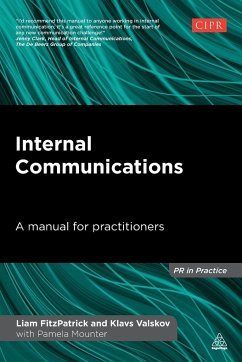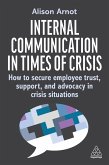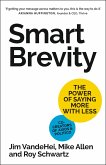- Broschiertes Buch
- Merkliste
- Auf die Merkliste
- Bewerten Bewerten
- Teilen
- Produkt teilen
- Produkterinnerung
- Produkterinnerung
Learn what good practice looks like and how to apply it with this no-nonsense guide to devising an internal communications strategy.
Andere Kunden interessierten sich auch für
![Marketing Communications Marketing Communications]() PR SmithMarketing Communications42,99 €
PR SmithMarketing Communications42,99 €![Accessible Communications Accessible Communications]() Lisa RiemersAccessible Communications26,99 €
Lisa RiemersAccessible Communications26,99 €![Strategic Internal Communication Strategic Internal Communication]() Dr David CowanStrategic Internal Communication45,99 €
Dr David CowanStrategic Internal Communication45,99 €![Influential Internal Communication Influential Internal Communication]() Jenni FieldInfluential Internal Communication43,99 €
Jenni FieldInfluential Internal Communication43,99 €![Internal Communication in Times of Crisis Internal Communication in Times of Crisis]() Alison ArnotInternal Communication in Times of Crisis28,99 €
Alison ArnotInternal Communication in Times of Crisis28,99 €![Unlocking Happiness at Work Unlocking Happiness at Work]() Unlocking Happiness at Work Jennifer MossUnlocking Happiness at Work16,99 €
Unlocking Happiness at Work Jennifer MossUnlocking Happiness at Work16,99 €![Smart Brevity Smart Brevity]() Roy SchwartzSmart Brevity12,99 €
Roy SchwartzSmart Brevity12,99 €-
-
-
Learn what good practice looks like and how to apply it with this no-nonsense guide to devising an internal communications strategy.
Produktdetails
- Produktdetails
- PR In Practice
- Verlag: Kogan Page Ltd
- Seitenzahl: 272
- Erscheinungstermin: 1. August 2014
- Englisch
- Abmessung: 234mm x 156mm x 15mm
- Gewicht: 420g
- ISBN-13: 9780749469320
- ISBN-10: 0749469323
- Artikelnr.: 39122645
- Herstellerkennzeichnung
- Libri GmbH
- Europaallee 1
- 36244 Bad Hersfeld
- gpsr@libri.de
- PR In Practice
- Verlag: Kogan Page Ltd
- Seitenzahl: 272
- Erscheinungstermin: 1. August 2014
- Englisch
- Abmessung: 234mm x 156mm x 15mm
- Gewicht: 420g
- ISBN-13: 9780749469320
- ISBN-10: 0749469323
- Artikelnr.: 39122645
- Herstellerkennzeichnung
- Libri GmbH
- Europaallee 1
- 36244 Bad Hersfeld
- gpsr@libri.de
Liam FitzPatrick is Joint Managing Partner of change communication consultancy Agenda Strategies. He has worked both in-house and for major consultancies running change campaigns, developing communications teams and advising on metrics and evaluation. Liam co-founded the Black Belt series of training for internal communicators and lectures and has served as an external examiner at UK universities. A Fellow of the UK Chartered Institute of Public Relations, he has been involved in planning the education and training of PR practitioners. He is a also member of the Global Certification Council of the International Association of Business Communicators. Klavs Valskov is Joint Managing Partner of change communication consultancy Agenda Strategies. Since 1999 he has worked in PR, marketing and communication with organisations including L'Oreal, Accenture, Nordea Bank and the Danish Government. From 2008-2013 Klavs was the award-winning Global Director of Communication in Maersk Line managing a team around the world working on public relations, crises, internal communications, social media and customer campaigns. Klavs is part of the Advisory Board at the Institute of Business Communication at Copenhagen Business School. He holds a double MA in Communication and Business Studies.
List of figures
List of tables
Foreword by Anne Gregory
Foreword by James Harkness
Acknowledgements
Before we start
01 What internal communication is and why it matters
What you will learn from this chapter
Internal communication is coming of age
Definitions
It's not about telling - it's a two-way thing
Getting strategic
Ethics
The key learning points from this chapter
Notes and references
02 Organizing internal communication
What you will learn from this chapter
A little history
The big answer
How do you decide what you need?
Working with suppliers
The key learning points from this chapter
Notes and references
03 Planning
What you will learn from this chapter
The essential steps of planning
Templates for a communication plan
The key learning points from this chapter
04 Audiences
What you will learn from this chapter
Why understanding your audience is important
The basics - the demographics every internal communicator needs to know
Segmentation: One size does not fit all!
The key learning points from this chapter
Notes and references
05 Messaging
What you will learn from this chapter
What is a message?
Making it supportable
Making the case for a change - dilemmas, proof and emotion
Keeping it simple
Planning your message - a standard template
Channels and messages
The key learning points from this chapter
Notes and references
06 Channels
What you will learn from this chapter
It's all about results
The medium is the message
Social media - misunderstandings and opportunities
Conducting a basic channels audit
Discovering what good looks like
A channels matrix
The key learning points from this chapter
Notes and references
07 Why line managers matter and how to support them
What you will learn from this chapter
The line manager as the make-or-break factor
It's not what you do but the way that you do it: the five key questions
The key learning points from this chapter
Notes and references
08 Working with senior leaders
What you will learn from this chapter
Why should anyone care about making the CEO look good?
The boss and engagement
Why should the IC team care?
What does it mean to be a 'trusted adviser'?
Getting your plan sorted
Channels and tools that work
The key learning points from this chapter
Notes and references
09 Change
What you will learn from this chapter
What is change? Getting the terms right
Some theory
A planning template
Preparing leaders
Keeping communications going through the life of a change
The key learning points from this chapter
Notes and references
10 Research and evaluation for internal communicators
What you will learn from this chapter
Why do internal communicators need data?
What should you measure?
Audits - creating the communicators' balance sheet
Where can you find your data?
Quantitative measures - surveys and tracking
Qualitative approaches
Resources
The key learning points from this chapter
Notes and references
11 Developing yourself and the team
What you will learn from this chapter
What makes a great IC professional?
It's about the role
What skills, knowledge or experience do I need to do a good job?
How do I get better?
The key learning points from this chapter
Notes and references
Appendix 1: The CIPR Code of Conduct
Appendix 2: Dewhurst and FitzPatrick's core competencies
Index
List of tables
Foreword by Anne Gregory
Foreword by James Harkness
Acknowledgements
Before we start
01 What internal communication is and why it matters
What you will learn from this chapter
Internal communication is coming of age
Definitions
It's not about telling - it's a two-way thing
Getting strategic
Ethics
The key learning points from this chapter
Notes and references
02 Organizing internal communication
What you will learn from this chapter
A little history
The big answer
How do you decide what you need?
Working with suppliers
The key learning points from this chapter
Notes and references
03 Planning
What you will learn from this chapter
The essential steps of planning
Templates for a communication plan
The key learning points from this chapter
04 Audiences
What you will learn from this chapter
Why understanding your audience is important
The basics - the demographics every internal communicator needs to know
Segmentation: One size does not fit all!
The key learning points from this chapter
Notes and references
05 Messaging
What you will learn from this chapter
What is a message?
Making it supportable
Making the case for a change - dilemmas, proof and emotion
Keeping it simple
Planning your message - a standard template
Channels and messages
The key learning points from this chapter
Notes and references
06 Channels
What you will learn from this chapter
It's all about results
The medium is the message
Social media - misunderstandings and opportunities
Conducting a basic channels audit
Discovering what good looks like
A channels matrix
The key learning points from this chapter
Notes and references
07 Why line managers matter and how to support them
What you will learn from this chapter
The line manager as the make-or-break factor
It's not what you do but the way that you do it: the five key questions
The key learning points from this chapter
Notes and references
08 Working with senior leaders
What you will learn from this chapter
Why should anyone care about making the CEO look good?
The boss and engagement
Why should the IC team care?
What does it mean to be a 'trusted adviser'?
Getting your plan sorted
Channels and tools that work
The key learning points from this chapter
Notes and references
09 Change
What you will learn from this chapter
What is change? Getting the terms right
Some theory
A planning template
Preparing leaders
Keeping communications going through the life of a change
The key learning points from this chapter
Notes and references
10 Research and evaluation for internal communicators
What you will learn from this chapter
Why do internal communicators need data?
What should you measure?
Audits - creating the communicators' balance sheet
Where can you find your data?
Quantitative measures - surveys and tracking
Qualitative approaches
Resources
The key learning points from this chapter
Notes and references
11 Developing yourself and the team
What you will learn from this chapter
What makes a great IC professional?
It's about the role
What skills, knowledge or experience do I need to do a good job?
How do I get better?
The key learning points from this chapter
Notes and references
Appendix 1: The CIPR Code of Conduct
Appendix 2: Dewhurst and FitzPatrick's core competencies
Index
List of figures
List of tables
Foreword by Anne Gregory
Foreword by James Harkness
Acknowledgements
Before we start
01 What internal communication is and why it matters
What you will learn from this chapter
Internal communication is coming of age
Definitions
It's not about telling - it's a two-way thing
Getting strategic
Ethics
The key learning points from this chapter
Notes and references
02 Organizing internal communication
What you will learn from this chapter
A little history
The big answer
How do you decide what you need?
Working with suppliers
The key learning points from this chapter
Notes and references
03 Planning
What you will learn from this chapter
The essential steps of planning
Templates for a communication plan
The key learning points from this chapter
04 Audiences
What you will learn from this chapter
Why understanding your audience is important
The basics - the demographics every internal communicator needs to know
Segmentation: One size does not fit all!
The key learning points from this chapter
Notes and references
05 Messaging
What you will learn from this chapter
What is a message?
Making it supportable
Making the case for a change - dilemmas, proof and emotion
Keeping it simple
Planning your message - a standard template
Channels and messages
The key learning points from this chapter
Notes and references
06 Channels
What you will learn from this chapter
It's all about results
The medium is the message
Social media - misunderstandings and opportunities
Conducting a basic channels audit
Discovering what good looks like
A channels matrix
The key learning points from this chapter
Notes and references
07 Why line managers matter and how to support them
What you will learn from this chapter
The line manager as the make-or-break factor
It's not what you do but the way that you do it: the five key questions
The key learning points from this chapter
Notes and references
08 Working with senior leaders
What you will learn from this chapter
Why should anyone care about making the CEO look good?
The boss and engagement
Why should the IC team care?
What does it mean to be a 'trusted adviser'?
Getting your plan sorted
Channels and tools that work
The key learning points from this chapter
Notes and references
09 Change
What you will learn from this chapter
What is change? Getting the terms right
Some theory
A planning template
Preparing leaders
Keeping communications going through the life of a change
The key learning points from this chapter
Notes and references
10 Research and evaluation for internal communicators
What you will learn from this chapter
Why do internal communicators need data?
What should you measure?
Audits - creating the communicators' balance sheet
Where can you find your data?
Quantitative measures - surveys and tracking
Qualitative approaches
Resources
The key learning points from this chapter
Notes and references
11 Developing yourself and the team
What you will learn from this chapter
What makes a great IC professional?
It's about the role
What skills, knowledge or experience do I need to do a good job?
How do I get better?
The key learning points from this chapter
Notes and references
Appendix 1: The CIPR Code of Conduct
Appendix 2: Dewhurst and FitzPatrick's core competencies
Index
List of tables
Foreword by Anne Gregory
Foreword by James Harkness
Acknowledgements
Before we start
01 What internal communication is and why it matters
What you will learn from this chapter
Internal communication is coming of age
Definitions
It's not about telling - it's a two-way thing
Getting strategic
Ethics
The key learning points from this chapter
Notes and references
02 Organizing internal communication
What you will learn from this chapter
A little history
The big answer
How do you decide what you need?
Working with suppliers
The key learning points from this chapter
Notes and references
03 Planning
What you will learn from this chapter
The essential steps of planning
Templates for a communication plan
The key learning points from this chapter
04 Audiences
What you will learn from this chapter
Why understanding your audience is important
The basics - the demographics every internal communicator needs to know
Segmentation: One size does not fit all!
The key learning points from this chapter
Notes and references
05 Messaging
What you will learn from this chapter
What is a message?
Making it supportable
Making the case for a change - dilemmas, proof and emotion
Keeping it simple
Planning your message - a standard template
Channels and messages
The key learning points from this chapter
Notes and references
06 Channels
What you will learn from this chapter
It's all about results
The medium is the message
Social media - misunderstandings and opportunities
Conducting a basic channels audit
Discovering what good looks like
A channels matrix
The key learning points from this chapter
Notes and references
07 Why line managers matter and how to support them
What you will learn from this chapter
The line manager as the make-or-break factor
It's not what you do but the way that you do it: the five key questions
The key learning points from this chapter
Notes and references
08 Working with senior leaders
What you will learn from this chapter
Why should anyone care about making the CEO look good?
The boss and engagement
Why should the IC team care?
What does it mean to be a 'trusted adviser'?
Getting your plan sorted
Channels and tools that work
The key learning points from this chapter
Notes and references
09 Change
What you will learn from this chapter
What is change? Getting the terms right
Some theory
A planning template
Preparing leaders
Keeping communications going through the life of a change
The key learning points from this chapter
Notes and references
10 Research and evaluation for internal communicators
What you will learn from this chapter
Why do internal communicators need data?
What should you measure?
Audits - creating the communicators' balance sheet
Where can you find your data?
Quantitative measures - surveys and tracking
Qualitative approaches
Resources
The key learning points from this chapter
Notes and references
11 Developing yourself and the team
What you will learn from this chapter
What makes a great IC professional?
It's about the role
What skills, knowledge or experience do I need to do a good job?
How do I get better?
The key learning points from this chapter
Notes and references
Appendix 1: The CIPR Code of Conduct
Appendix 2: Dewhurst and FitzPatrick's core competencies
Index









